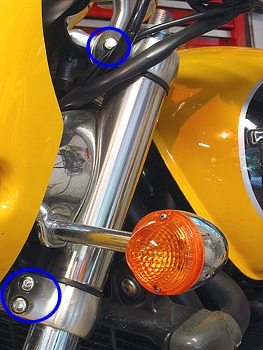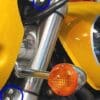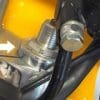Raising the fork tubes in the triple clamp is a simple adjustment that can help make a motorcycle respond faster to steering input and can lower the motorcycle.
This trick won’t be found in your owner’s manual, because the manufacturers spend a lot of time working out the best compromise for the motorcycle’s suspension, and they really don’t want you messing with it. This old racer’s trick changes the bike’s apparent rake and trail, usually enough to make a noticeable difference on most motorcycles.
It also lowers the seat height slightly, although depending upon the bike, the difference may be so small as to be undetectable. But sometimes every millimeter counts, and the most common procedure to lower a motorcycle involves three things: first, get a lower seat of have the seat re-worked to lower the foam and make the front of the seat narrower if possible. This can sometimes lower a motorcycle by 25-35 mm (1″ to 1-38″).
Next, try raising the fork tubes in the triple clamp, which can lower the bike another few millimeters. The third and most complicated step is to lower the bike’s rear suspension. This can involve anything from shorter shocks to replacing suspension parts, and often involves handling compromises. Try steps #1 and 2 first, and you may find that the bike can be lowered enough to fit.
Motorcycles with cruiser-style rake, like the 1994 BMW K75 I owned once, don’t seem to respond to this trick, because the fork tubes would have to be raised so far in the triple clamp to change the larger rake angle that the bike would become impossible to ride and the front suspension would probably bottom out.
My old K75 had such lame handling that even raising the fork tubes to an extreme amount didn’t help much. However, the Triumph Thunderbird Sport (TBS) seems to be very sensitive to fork tube height; after some experimenting, I’ve found that raising the fork tubes on this bike noticeably speeds up the steering.
After some experimentation, I settled on raising the fork tubes by 10 mm. This seems to be just the right amount to make the steering more lively and responsive without getting too radical. I suggest settings between 10 mm and 15 mm.
The steering becomes very quick when the tubes are raised 15 mm, and certainly the bike is great fun in fast left/right transitions. But that amount of change also causes the bike to develop a slight tendency to fall in to the turn and feels like it’s oversteering.
The handlebar inputs have to be very small and precise, or you’ll find yourself having to correct mid-corner. 15 mm might be good for a track day, but it takes a bit of the fun out of riding this bike because of the concentration needed to get through a corner. 10 mm seems just about perfect and much more reasonable — it’s enough to noticeably quicken the steering without making the bike feel too nervous.
You may want to experiment with your motorcycle to find a fork tube height that suits you. It will depend upon the motorcycle, the tires and the rider’s preference. But it’s usually a very easy project; on most bikes, the fork tubes can be raised by loosening up the upper and lower fork tube bolts that hold the forks in the upper and/or lower triple clamp.
Unless your TBS has the optional center stand, you’ll need to raise the bike up using a paddock, or swingarm stand (see the wBW review of the Steel Horse swingarm stand, a very well made stand which also works very nicely on the Thunderbird Sport) for this project.
I suppose it could be done with the bike on the side stand, but since I own a swingarm stand, I’ve never tried it any other way.
You’ll probably need to place a jack underneath the bike for this project, because it’s very easy to raise the fork tubes, but not easy to lower them if you don’t get it exactly right the first time.
I use a hydraulic scissor jack underneath the oil pan, and I place a flat piece of wood between the jack and the engine to protect the aluminum.
Next, pry off the chrome plastic clamp bolt covers. You’ll need a 5 mm Allen wrench (a 5 mm hex drive on a short ratchet extension works best) and loosen the clamp bolts.
It’s not necessary to completely remove the bolts, just loosen them up enough so that the fork tubes will slide up in the triple clamp.
Once the bolts are loose, a light push down on the hand

You’ll probably find that it’s very easy to overdo it; in fact, it’s actually easier to get the fork tubes way higher than necessary, and then slowly jack the bike up and tap on the top of the fork tubes with a piece of wood until they’re lowered to the desired height. As I mentioned above, I suggest you start with 10 mm. It’s easy enough to get both fork tubes at an even height by using a metric scale graduated in 1 mm increments.
Once you have both fork tubes at an even height, tighten up the clamp bolts to the correct torque specifications for your bike and take it for a test ride. Be careful at first to get a feel for the way the bike handles.
This is a great way to brighten up the handling on the TBS and other motorcycles could probably also benefit from raising the fork tubes. It’s easy enough to do and you can always put them back to their stock position if you don’t like the results.





